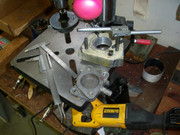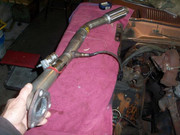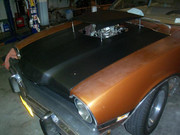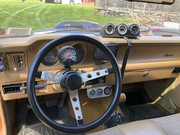Looking to turbo charge my inline 6 200 on my 1971 Mercury Comet. I have a t4 turbo and an aluminum carb plenum from a 1981 Buick turbo 3.8. Currently looking for recommendations for carburetor, setup, or different turbo. Are there any mods to the engine that need to be made? Just looking to make 8 to 10 lbs of boost.
You are using an out of date browser. It may not display this or other websites correctly.
You should upgrade or use an alternative browser.
You should upgrade or use an alternative browser.
All Small Six 200 Inline 6 Draw Thru Turbo
- Thread starter bryanh363
- Start date
This relates to all small sixes
If your planning to draw through, you need a turbo with a compressor seal suitable for vacuum applications. T4 might be a bit big, t3 maybe better. You will need a carb big enough to support the flow you desire, so something around 500cfm i would think would be minimum, say a DCOE 40-45weber, 2 inch SU? Sidedraft probably easiest to work with. As to your base engine, you should be OK with all stock stuff, provided your not doing any sustained full throttle runs, you might need to recurve the dizzy to work right with boost. the biggest problem I can see is the attachment to the exhaust manifold, you might need to fabricate something for this
Just looking to make 8 to 10 lbs of boost.
give it a try ! , the inline six and Draw-thru setup is simplest for forced induction conversion. Doesn't need fuel - pump/ref'd/return like blow-thru.
8 - 10 lbs of boost is optimistic for stock internals even with the robustness of the small block six.
The Draw-Thru forced induction setup has some quirks to be addressed just as Blow-Thru setups. With pressurized - fuel enriched gas , the Turbo seals are an example of attention ...
the '74 Maverick used a complete Buick 231 V6 Draw Thru system with greatly improved performance - for @ week ...
search forum on " Draw Thru " and all kinds of info is available :
from previous:
Ford 'Stang 2.3 Turbo like virtually all early turbo's used a DRAW-THRU setup where the carb is before the turbo .With the advent of throttle and then multi-port electronic fuel injection the draw-thru turbo and special-'built for boost carbs' era ended.
Holley 6500 2-barrel into AirResearch TO-3 turbo is listed as 1980 OEM Mustang carb. 6500 is probably tweaked 5200 series to accommodate the turbo's needs.
To accomplish draw-thru performance, the Carburetor needs to be able to emulate a small CFM carb at No-Boost from idle to spool up, then have a huge CFM increase as boost builds. The opposite is true of carbs used for Blow-Thru setups where a smaller CFM carb is often required for good AFR's when engine is converted to forced induction.
Draw-Thru turbo's were also used on the same era Pontiac - Buick V6's before FI '- Grand Nationals.
first built the project inline 250 with a Buick derived Turbocharger setup in the Maverick, with the BOP T3/Draw-thru/Thermo-Quadrajet setup
"This carb also has a power valve that is held closed with manifold vacuum."
Unique to BOP turbos' - external PV port Qjet' referenced to intake vac/boost. (81 Regal) 231 V6 Draw-Thru T3 Turbo / Unique Quadrajet 4Bbl (950 CFM at WOT Boost for 231 CID! - with low CFM off boost.
Manifold Vac at idle is normal until spool up and boost, also at light cruise very little change from NA.
the universally available Holley 2300 series is a favorite for 'simple' modification to BLOW_THROUGH forced induction, for Draw-Thru using a
purpose-built OEM carb for the wide CFM range needed is probably simplest ....
some encouragement :
 .
.  .
. 
;
 .
.  '
' 
.
. .
.  .
. 
l
Hav e Fun
give it a try ! , the inline six and Draw-thru setup is simplest for forced induction conversion. Doesn't need fuel - pump/ref'd/return like blow-thru.
8 - 10 lbs of boost is optimistic for stock internals even with the robustness of the small block six.
The Draw-Thru forced induction setup has some quirks to be addressed just as Blow-Thru setups. With pressurized - fuel enriched gas , the Turbo seals are an example of attention ...
the '74 Maverick used a complete Buick 231 V6 Draw Thru system with greatly improved performance - for @ week ...
search forum on " Draw Thru " and all kinds of info is available :
from previous:
Ford 'Stang 2.3 Turbo like virtually all early turbo's used a DRAW-THRU setup where the carb is before the turbo .With the advent of throttle and then multi-port electronic fuel injection the draw-thru turbo and special-'built for boost carbs' era ended.
Holley 6500 2-barrel into AirResearch TO-3 turbo is listed as 1980 OEM Mustang carb. 6500 is probably tweaked 5200 series to accommodate the turbo's needs.
To accomplish draw-thru performance, the Carburetor needs to be able to emulate a small CFM carb at No-Boost from idle to spool up, then have a huge CFM increase as boost builds. The opposite is true of carbs used for Blow-Thru setups where a smaller CFM carb is often required for good AFR's when engine is converted to forced induction.
Draw-Thru turbo's were also used on the same era Pontiac - Buick V6's before FI '- Grand Nationals.
first built the project inline 250 with a Buick derived Turbocharger setup in the Maverick, with the BOP T3/Draw-thru/Thermo-Quadrajet setup
"This carb also has a power valve that is held closed with manifold vacuum."
Unique to BOP turbos' - external PV port Qjet' referenced to intake vac/boost. (81 Regal) 231 V6 Draw-Thru T3 Turbo / Unique Quadrajet 4Bbl (950 CFM at WOT Boost for 231 CID! - with low CFM off boost.
Manifold Vac at idle is normal until spool up and boost, also at light cruise very little change from NA.
the universally available Holley 2300 series is a favorite for 'simple' modification to BLOW_THROUGH forced induction, for Draw-Thru using a
purpose-built OEM carb for the wide CFM range needed is probably simplest ....
some encouragement :
 .
.  .
. 
;
 .
.  '
' 
.
.
 .
.  .
. 
l
Hav e Fun
You absolutely need to have a carbon seal otherwise you will be burning oil. Make sure you run an oil restrictor in the turbo and it’s has a nice free flowing return.I am mocking up the intake now to try and get everything in place and fitting good. What size t3 turbo would be best? I did find carbon seal back plates. Would that suffice or is there a specific turbo I should get? New to draw through turbos.
Draw through setups use to be common in drag bikes back in the day, not many people play around with them but you could try some of the VW beetle guys they run draw through setups.
Mr Turbo uses one company that did bikes from memory, not sure if they are still around.
Knowing what I know now, I would not do draw through, and I am now working on MPEFI.
Yes, I would.
" Knowing what I know now ... "
... learned quickly that whether Blow-thru, Draw-Thru or supercharged, the essential hardware of Forced Induction isn't impossible to achieve fairly simply and inexpensively with enough enthusiasm .
.. the 250 Draw-Thru project illustrated to me, the need for a 'whole system' approach to forced induction conversion. 250 Maverick now uses a Supercharger - Blowing Thru - a modified Holley 2Bbl. "modern" fuel and ignition controls, return/referenced supply, realtime boost and AFR monitoring enable the Maverick reliable - optimized performance.
hav e fun
 .
. 
... learned quickly that whether Blow-thru, Draw-Thru or supercharged, the essential hardware of Forced Induction isn't impossible to achieve fairly simply and inexpensively with enough enthusiasm .
.. the 250 Draw-Thru project illustrated to me, the need for a 'whole system' approach to forced induction conversion. 250 Maverick now uses a Supercharger - Blowing Thru - a modified Holley 2Bbl. "modern" fuel and ignition controls, return/referenced supply, realtime boost and AFR monitoring enable the Maverick reliable - optimized performance.
hav e fun
 .
. 
"...the need for a 'whole system' approach..."
designed w/each piece in mind, assuring success in part and whole, before the build.
Yeah, still gotta test, but assure success w/"May B add this here, that there?"
Interested in an excersion over to the forum for that?
designed w/each piece in mind, assuring success in part and whole, before the build.
Yeah, still gotta test, but assure success w/"May B add this here, that there?"
Interested in an excersion over to the forum for that?
PSIG
Famous Member
To avoid issues and frustrations, you need more info than this. Starting with a specific goals list (what do you expect it to do?), you can determine how to get there, and what parts will be best suited. Note there are many T4 turbo versions, and most will be unsuitable. Post the spec's for yours. I suggest a review of your plan and some confirmations before investing too much time. A bit of "look before you jump" to save time and money.I have a t4 turbo
Unless doing an 1980s period piece, and depending on if it's for show, fun, or serious go, I'd side-step the draw-through if at all possible, due to some technical and tuning issues you will face. I'd be more in-favor of blow-through carb or TBI (but with some limiting fuel distribution issues) or an MPFI conversion, in increasing order of preference. All valid paths, with strong benefits and detriments to each.
Ultimately I am looking to push around 180 to 200 hp. I wanted to get the aluminum head but they are very difficult to get hands on for a reasonable price. I have also considered a supercharger setup and blow through setup. Currently talking to my machine shop to see what they can accomplish without forced induction to see what is actually possible and cost efficient.
PSIG
Famous Member
Pick your path, but boost can be far less expensive, or easier, depending on goals and fab skills. In this case, 180-200hp, with good fuel and timing tuning, 6 psig boost is right at 185hp with a bone stock engine (except fresh or up-rated valve springs) at 5000 rpm. Pushing a bit over 200hp at 8 psig. That's 289 2-barrel performance. With a touch of water injection and 11 psi, about 225 hp for 289 4V performance. Actually a bit better as the torque curve is wider, and 200cc/min of water (instead of an intercooler) will push it to about 250hp.
For the power and especially solid reliability, tuning is the key "part" to invest in. Any improvements for NA performance either add to power with boost or need less boost to hit the same power. So, mods are good if they don't suck too much budget or time. This stuff is only to indicate a baseline for options to meet your goals, and to compare with other options.
I used stock specifications for calculations, and extended cam curves under boost. Typical calc results are close, and conservative. At 6 psi, the turbo isn't making enough heat to warrant an intercooler, so it's a matter of adapting the exhaust for the turbo with internal or external wastegate, the charge piping, shimming or swapping the valve springs for a bit of rpm and to offset boost pressure, a step colder spark plugs, a tank of good fuel, and start tuning.
*Calculations were at 12.8:1, 0.5 BSFC, stock head 68% VE, NA peak power at 4400, compressor efficiency 75%. At peak rpm and 8 psi, the flow to plot a good turbo is 260 CFM (19.5 lb·min or 0.123 M3/sec). Hope that helps!
For the power and especially solid reliability, tuning is the key "part" to invest in. Any improvements for NA performance either add to power with boost or need less boost to hit the same power. So, mods are good if they don't suck too much budget or time. This stuff is only to indicate a baseline for options to meet your goals, and to compare with other options.
I used stock specifications for calculations, and extended cam curves under boost. Typical calc results are close, and conservative. At 6 psi, the turbo isn't making enough heat to warrant an intercooler, so it's a matter of adapting the exhaust for the turbo with internal or external wastegate, the charge piping, shimming or swapping the valve springs for a bit of rpm and to offset boost pressure, a step colder spark plugs, a tank of good fuel, and start tuning.
*Calculations were at 12.8:1, 0.5 BSFC, stock head 68% VE, NA peak power at 4400, compressor efficiency 75%. At peak rpm and 8 psi, the flow to plot a good turbo is 260 CFM (19.5 lb·min or 0.123 M3/sec). Hope that helps!
PSIG
Famous Member
Assuming you will have substantially more power when you're done with your mods, the impact of gearing will change. Based on your stock cam peak torque around 2200 rpm, 25" tires, 1:1 top gear and 70 mph cruise target; a gear around 2:50 would provide optimal economy.
While bang-for-the-buck acceleration is high with a gear change, and deeper gears take you to boost rpm quicker — IMO wait to do the power mods, then drive it around to see if you really feel you want or need a gear change (up or down) in order to balance economy with on-ramps. That also means you get to set the priorities based on you and how it drives. Everything is a compromise.
While bang-for-the-buck acceleration is high with a gear change, and deeper gears take you to boost rpm quicker — IMO wait to do the power mods, then drive it around to see if you really feel you want or need a gear change (up or down) in order to balance economy with on-ramps. That also means you get to set the priorities based on you and how it drives. Everything is a compromise.
"While bang-for-the-buck acceleration is high with a gear change, and deeper gears take you to boost rpm quicker — IMO wait to do the power mods, then drive it around to see if you really feel you want or need a gear change (up or down)"
with boost there's a power application curve that can be geared to your driving and the available engine performance.
With the SC'd 250 Maverick I first swapped in same gears as the NA TriPower 250 Comet - 3.80:1 posi'. The NA 250 with 3.80 gears is about right with OD T5 but the SC'd Maverick would go into boost at too low ground speed with the engine RPM rising. Swapping in the OEM 2.89:1 rear moved the start-off and cruise RPM below boost and provides boost above @ 2K rpm dependent on throttle opening position.
have fun
with boost there's a power application curve that can be geared to your driving and the available engine performance.
With the SC'd 250 Maverick I first swapped in same gears as the NA TriPower 250 Comet - 3.80:1 posi'. The NA 250 with 3.80 gears is about right with OD T5 but the SC'd Maverick would go into boost at too low ground speed with the engine RPM rising. Swapping in the OEM 2.89:1 rear moved the start-off and cruise RPM below boost and provides boost above @ 2K rpm dependent on throttle opening position.
have fun
Similar threads
All Small Six
New Adventures in electrics fans and inline 6’s
- Replies
- 22
- Views
- 1K
All Small Six
My 200 CI mystery
- Replies
- 130
- Views
- 12K
- Replies
- 123
- Views
- 8K
Build Thread
Turbo 250 Mod Log 2.0
- Replies
- 31
- Views
- 6K
